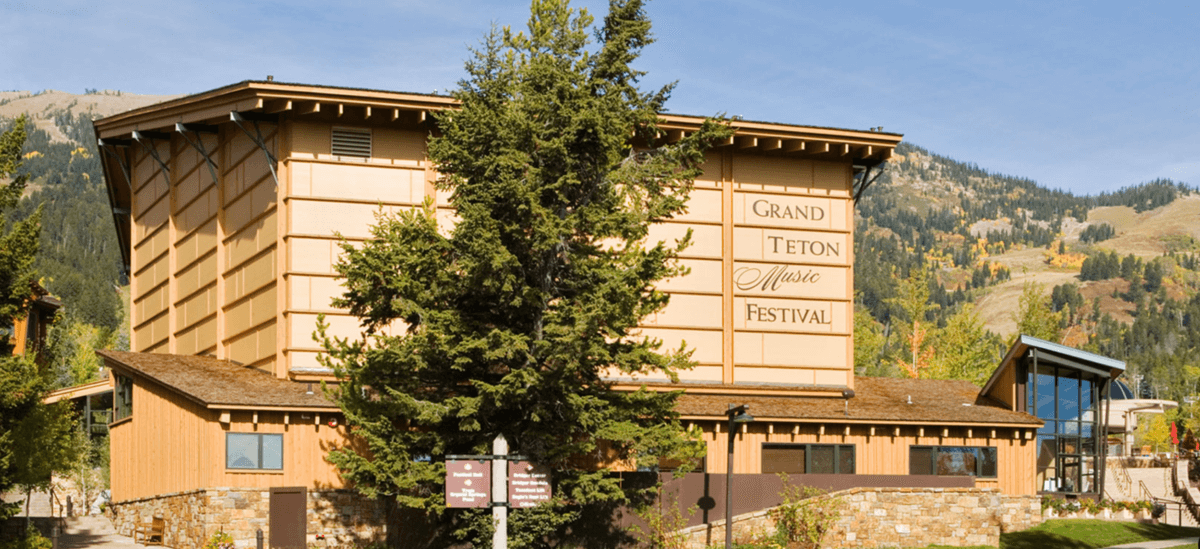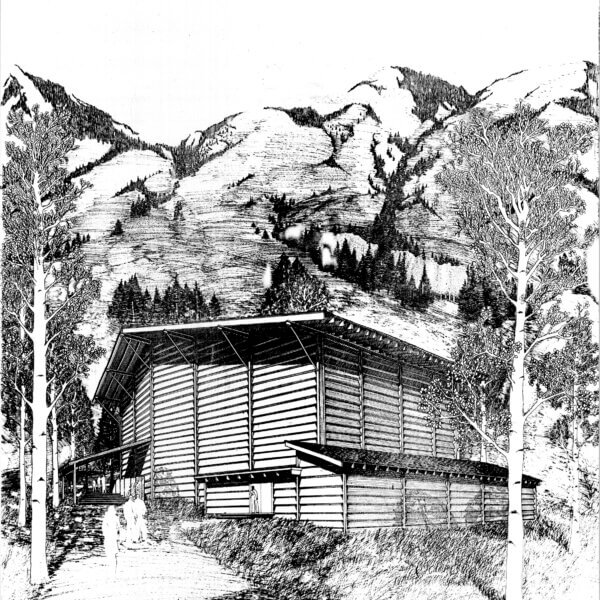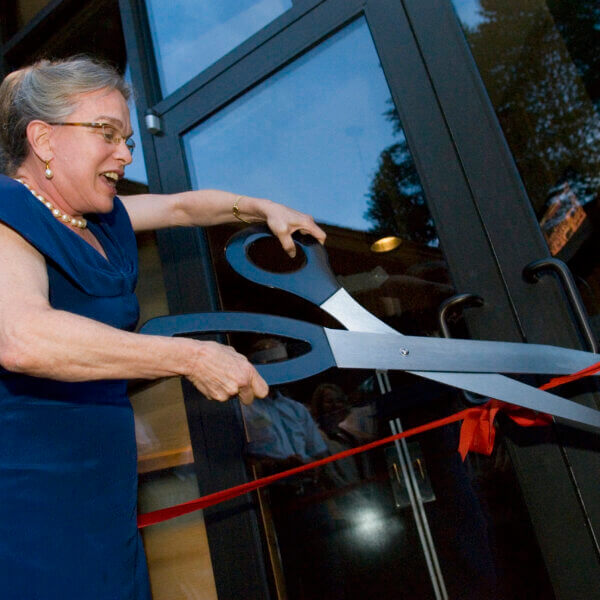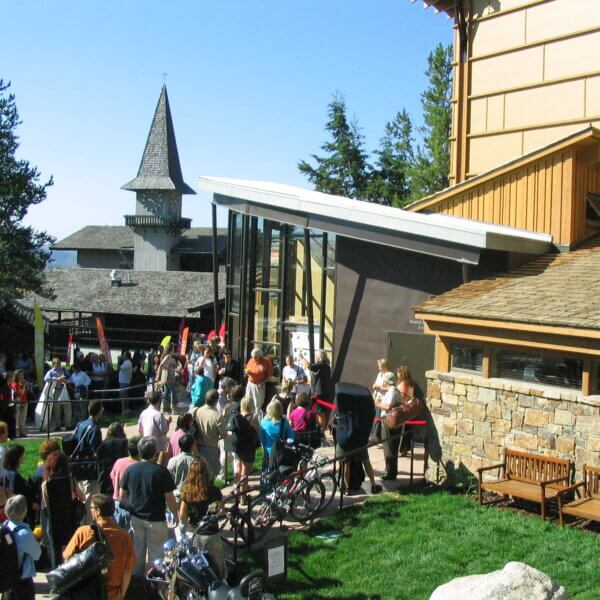Celebrating 50 Years of Walk Festival Hall

This article was first published in the GTMF 2024 Summer Program Book.
Summing up the impact of Walk Festival Hall is perhaps an impossible task. How can you measure the music that fills these walls? The community forged by our orchestra and audience? The decades of memories and musical triumphs that we bring home with us after each season?
As we celebrate this, the 50th anniversary of Walk Festival Hall, we reflect on what it has meant to have a permanent home at the base of the Teton range.
“The beauty of the area enhances your musicianship. You’re a happy person in the Tetons,” says Gail Williams, GTMF Principal Horn and Professor at Northwestern University. Over her 32 years at GTMF, Williams says her musical experiences on stage are the highlights of her time at the Festival.
“The hall that an artist plays in becomes part of their personality, and you play in a certain style because of your hall,” Williams says. “As the orchestra plays, everybody adjusts to the space each year. I think that makes it our home.”
And what a home it has been—over the last 50 years, these walls have reflected back the soundwaves of numerous musical triumphs, from the concert featuring 300 members of the Mormon Tabernacle Choir and the GTMF Orchestra in 1993 to the 2023 release of Beethoven’s complete piano concertos featuring pianist Garrick Ohlsson.
“Walk Festival Hall is, in essence, a finely tuned instrument that our musicians are thrilled to play and to learn from. It is an acoustical marvel,” says Sir Donald Runnicles, GTMF Music Director.
“It is no coincidence that most of the world’s great orchestras rehearse and perform in great halls,” says Runnicles. “A superior hall informs the orchestra’s sound, influencing orchestral blend, interior balance and warmth.”
From the audience, we experience this immersive warmth along with the orchestra. Susan Sutton, Vice Chair of the GTMF Board, says the intimate atmosphere of Walk Festival Hall enhances the music.
“As I get to know the musicians, it’s a bit like going to a baseball game and rooting for the player on first base,” she jokes. “You’re so up close and personal in that beautiful setting that you just can’t help but be completely absorbed by the music.”
When Preparation Meets Opportunity
Over the last half century, the Grand Teton Music Festival has brought a thrilling level of musical excellence to the Walk Festival Hall stage. The Festival has been around longer than its home, however. GTMF traces its origins back to 1962 when it was established as part of a broader effort to cultivate cultural activities in Jackson Hole, initially organized by the Jackson Hole Fine Arts Festival. The Festival took the name Grand Teton Music Festival and the shape we recognize today with the appointment of Ling Tung as Music Director in 1968. Prior to Walk Festival Hall’s opening season in 1974, Festival musicians played concerts in the now-demolished Jackson High School gymnasium and the Jackson Lake Lodge. For three seasons as the hall was being constructed, it moved to a large canvas tent on a plot of land in Teton Village.
Building Walk Festival Hall truly took a village. The Festival’s founding members—Baroness Consuelo von Gontard, her son Paul, George Hufsmith, Alex Morley, Grant Hagen and Marion Buchenroth, to name a few—dreamed early on of a concert hall. A home of its own would signal the Festival’s aspiration for musical excellence and permanence.
The hall we admire and enjoy today is the result of a true collaboration of three gifted individuals: Bob Corbett, Architect; Chris Jaffe, Acoustician; and Ling Tung, Music Director. It had the backing of Felix Buchenroth, President of the Jackson State Bank. Alex Morley and Paul McCollister of the Jackson Hole Ski Corporation donated the site in Teton Village.
Acoustician Chris Jaffe, acclaimed for his work on the Ravinia Festival Pavilion and the Blossom Festival Pavilion, brought his artistry and experience to the project. Corbett did not put pencil to paper until he had conferred with Jaffe and Tung, prioritizing acoustics above all else, throughout the design and building process.
Tung’s artistic vision for the Festival informed the Hall’s construction. “It was and is all about the musicians,” says Margot Walk, longtime GTMF Business Manager and Tung’s spouse. Tung’s core idea for the Festival was a resident orchestra bringing together the best of the best of our classical musicians. With that magical combination of artistic vision and musical excellence, the Festival quickly gained the momentum needed to build its permanent home in the village.
Construction commenced in 1972, supported by a leadership gift from Margot Walk’s father Maurice Walk. In total, funds raised for the project amounted to approximately $758,000 (worth $5.8 million in 2024). The project incorporated innovative design elements to optimize acoustics while accommodating the limited funds available.
The decision to use wood in construction, favored by both conductors and acoustical engineers, contributed to the hall’s warm and resonant sound. The unconventional choice of amphitheater seating enhanced intimacy between performers and audience, enriching the concert experience.
“Gil Ordway, a backbone supporter from the start, donated folding chairs for the front half of the hall. Seat cushions for the back half of the auditorium came from a vaudeville theater in Idaho Falls that was being renovated and was selling the seat cushions for a buck a piece,” says Walk. “Ling and I rented a truck, drove over the pass, filled up the truck with those cushions and put them in the upper rows of the hall.”
As mountain climbers adjusted the height and tilt of the acoustic panels over the stage days before the opening, Walk asked acoustician Chris Jaffe why he was quiet. He said, ‘I’m a little nervous. For the first time in my long career, I have been given everything I asked for,’” recalls Walk. Following his wish list paid off. The hall’s acoustics are renowned around the world, prized first and foremost by the musicians who perform there. Festival Hall officially opened its doors on July 18, 1974.
Bringing Walk Festival Hall Into the 21st Century
Over the years, ongoing improvements and additions, generously supported by patrons and foundations, enhanced the hall’s functionality and comfort. From theater seating to lighting upgrades and the construction of backstage facilities, Festival Hall evolved to meet the growing needs of the Festival and its patrons.
When the New York Philharmonic came for a two-week residency prior to the start of the Festival’s summer season in 1989, Tracy Jacobson, the first full-time Festival employee and former GTMF Executive Director, said that the residency helped the Festival identify more areas for facilities improvement, including installing bathrooms onsite. Prior to that renovation, concertgoers could use the Ski Corporation bathrooms in the Clock Tower building downhill—a race against time during intermission.
“I remember Senator Alan Simpson humorously expressing how happy he was that we were having restrooms installed so that he wouldn’t have to bump into his friends in the bushes,” Jacobson jokes.
One of the first renovations added the patron restrooms that were later raised up to their current location on the deck, creating a basement storage area beneath them. The project also included the addition of a concession stand and walkways around the hall to connect Walk Festival Hall to its neighbors and make the space more inviting.
By the early aughts, Teton Village had completely transformed from the sleepy fields upon which the hall was first built. What began as a small collection of homes and ski lodges exploded into the bustling village we enjoy today. However, with the increase in foot traffic came an uptick in noise around the hall.
“At that point, the weather had taken its toll on the building. The acoustics were fantastic, but you were able to see outside through gaps in the wood of the building,” says Jacobson.
“A lot of thought was put into the design process as there were many improvements desired, however, keeping the hall’s remarkable acoustical qualities was our top priority. The hall is like an instrument in the orchestra, and allowing it to continue to resonate properly was critical for a successful renovation,” Jacobson explains. Of the three options presented in the design phase for this renovation, the Festival chose the most complex and ambitious: building a new building around the original hall.
The day after Maestro Runnicles put down his baton at the conclusion of the 2006 summer season and over the course of nine months, Big D Construction built an exterior shell around the original wooden building, added a ticket office and constructed exterior vestibules, among many other updates and additions. This renovation, designed by Larry Berlin of Berlin Architects, ingeniously connected the exterior shell to the inner hall via gaskets, allowing the principal building to flex and reverberate sound as it previously did, with an added layer of insulation.
With sound at the top of the priority list, installing an HVAC system also presented a challenge, as concerts could not be disrupted by the sound of a fan turning on. As a result of this need, the HVAC system was designed and installed by Delcon, Inc. and duct work was lined with felt and sound attenuators to ensure inaudible air movement during performances.
“We also had to rebuild the stage, as the timbers were quite worn,” says Jacobson. “Because it was such an important part of the hall, we sourced rare, old-growth wood planks, similar to the original boards, and were able to rebuild it in the same manner it was originally installed. Even the final sanding and finish work, performed by Fates Flooring, was thoroughly discussed as we knew we needed to sustain the acoustical values.”
“When they replaced the floor, I was worried about how much of a difference it would make in the hall’s sound,” remembers Williams. “There was a little adjustment period, and now it’s a part of our hall.”
The renovation also updated backstage space and amenities for Festival musicians and guest artists. “The backstage was so modest back then,” says Jacobson. “One of the things we were able to do was move the library upstairs. We wanted to build an upstairs to the backstage, but at the time, there were other priorities and so much to be done in a limited time, so that part of the plan had to take a back burner.”
Additionally, the Festival was successful in converting the old library into the music director’s current lounge area and providing one soloist dressing room for visiting artists. “There was quite a list. I’m surprised we were able to accomplish so much with only $6 million,” says Jacobson. “We really stretched every dollar.”
Jacobson also stated, “Because the Jackson Hole Mountain Resort’s Gondola and the Teton Club’s Lodge were also under construction—and our good relationship and the support of our neighbors—we were able to collaborate with our Village partners to create comprehensive walkways, seating areas and landscaping that made the space around the Hall very welcoming and functional for our visitors.”
A High-Caliber Hall for Years to Come
Today, Walk Festival Hall is more than the sum of its parts—the passion of our founders, the excellence of our musicians, and the dedication of this community come together to make this hall a home.
“There’s a wonderful John Muir quote, ‘The snow is melting into music,’ and that is exactly what happens in the springtime in the Tetons. The snow melts and the music starts,” says Sutton. “Anyone who’s been here knows that this Festival is an absolute treasure, and it’s our job to preserve it.”
“Our kids grow up there, and our friendships grow musically and personally,” says Williams. “I’ve been able to share GTMF with a number of students that have come out and worked in the box office, stage crew and even gotten to play extra and come back as members.” This season, Williams and her former student Shelby Nugent, a seven-year member of GTMF and member of the Dallas Opera Orchestra, will play side-by-side in the horn section.
“Nestled into the spectacular mountainside, it is as unique and modest a venue for an international music festival as it is stunning and inspiring. Many are the mornings where I will encounter musicians likewise on bikes en route to our morning rehearsals. This heady synergy of mountains and music never grows old,” says Maestro Runnicles.
Through perseverance, visionary leadership and community support, the Grand Teton Music Festival realized its dream of a permanent home, ensuring a legacy of musical excellence and cultural enrichment for generations to come.
“We’re enjoying the fruits of the founders’ labors, and we owe it to them to preserve this wonderful hall for the next 50 years,” says Sutton. “I would like to commend Margot Walk for first and foremost building the hall and having such foresight and commitment to the organization. She’s been an absolute phenom, and she doesn’t stop.”
Look around the hall, and you’ll notice the little details that make the Festival Orchestra sing: carefully chosen wood lining the stage and walls; acoustic panels precisely hung from the ceiling; rows of seats flowing towards the stage. Then the details we can’t see: the gaskets allowing the original inner building to flex in its shell; the felt lining our HVAC system to silently cool the hall; and, most importantly, the magic made by our Festival Orchestra.
Each week, we commune in this space and experience the miracle of live music. The next time you join us, take a moment to appreciate the Grand Teton Music Festival’s enduring instrument—Walk Festival Hall.





